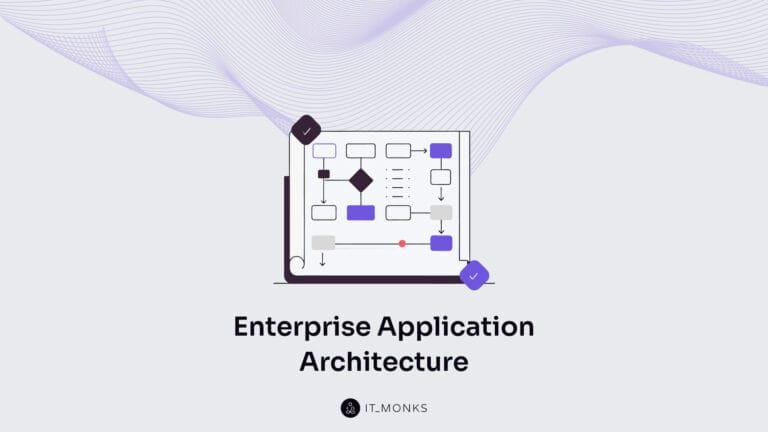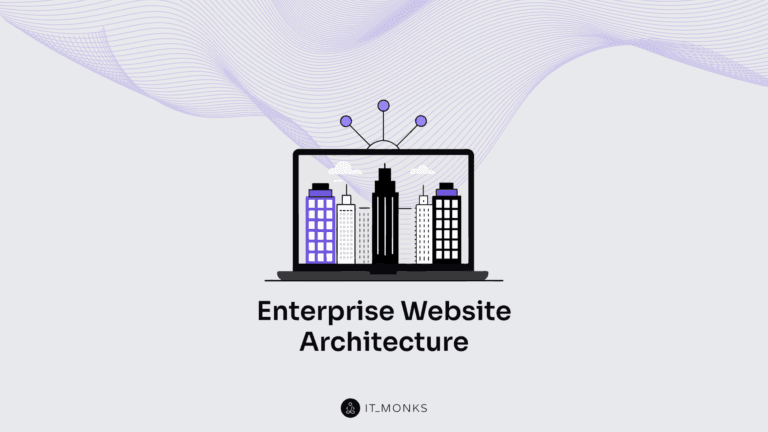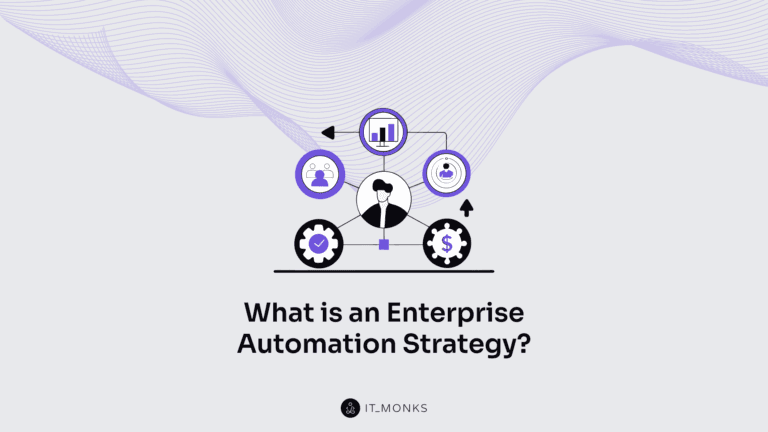Why is Enterprise Website Not Working?
Table of Contents
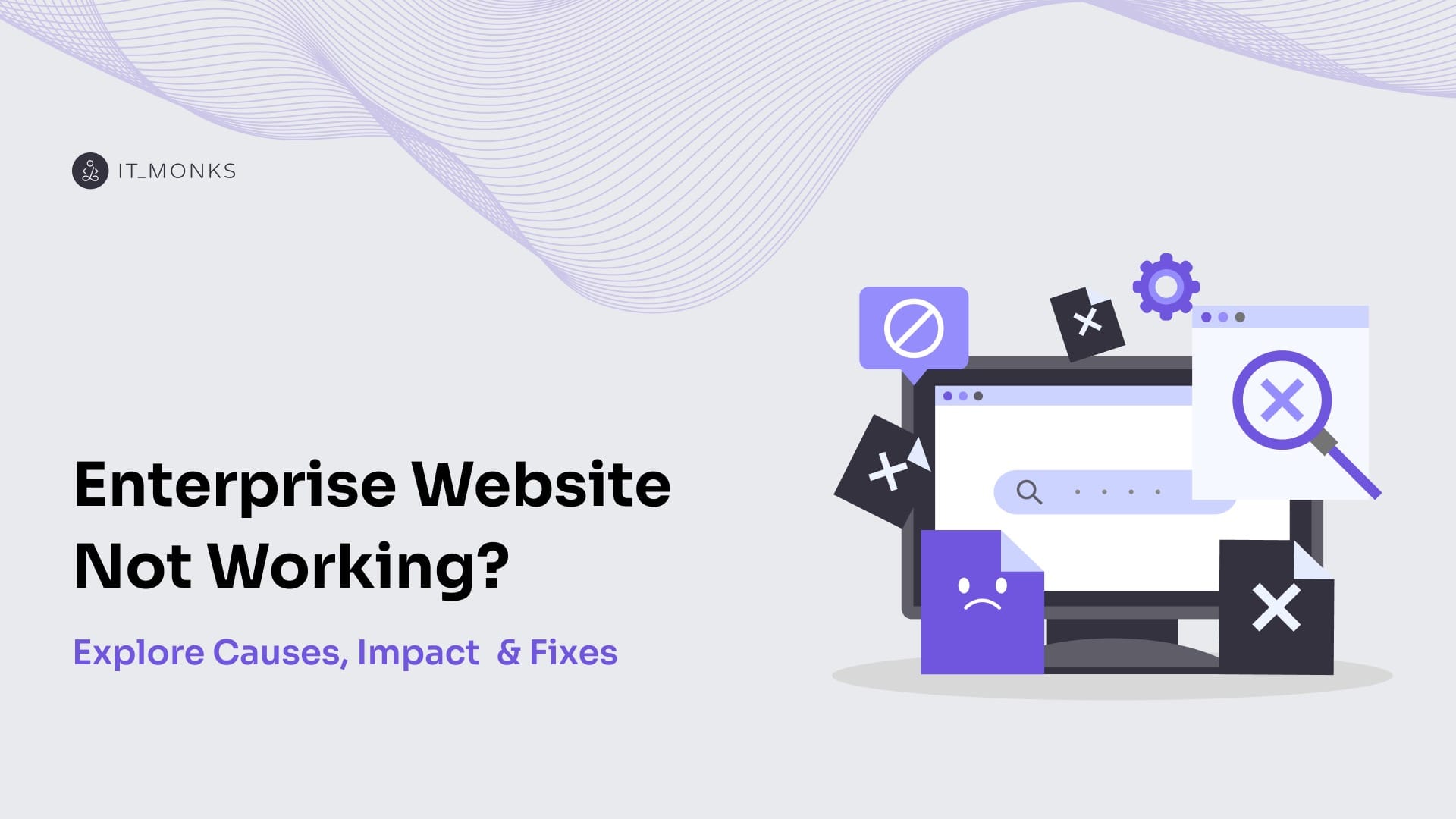
An enterprise website may not function properly due to server issues, browser incompatibility, unstable internet connections, scheduled maintenance, login errors, or temporary outages. Such problems can disrupt operations, result in missed lead generation opportunities, and erode the business’s competitive edge, ultimately damaging its brand perception.
To prevent downtime and its negative consequences, it’s important to have a well-built enterprise website, regularly monitor its performance, maintain it expertly, and ensure a timely installation of critical updates.
So, how exactly to troubleshoot and prevent common issues with enterprise websites?
This guide explores the primary causes and results of website malfunctioning and offers practical steps to prevent it, ensuring optimal functionality and reliability.
What Does It Mean for an Enterprise Website to ‘Not Work’?
When an enterprise website “doesn’t work,” it means users cannot access or browse the site, experiencing issues like slow loading times, broken features, error messages, or complete failure to load pages.
This impacts the website’s ability to perform key business functions, like customer interactions, information sharing, and supporting transactions.
The common scenarios of a website not working include:
- accessibility issues, where users can’t reach the site due to server errors or network problems;
- functionality problems, where features like forms or shopping carts don’t work;
- visual glitches, such as broken layouts or missing images that hinder navigation;
- security concerns, where outdated protocols or unsecured connections risk user data and discourage engagement.
Consequences of Enterprise Website Downtime
The consequences of an enterprise website experiencing downtime are:
- Lowering search engine rankings, as search engines consider website availability in their algorithms.
- Damaging the company’s reputation, especially when outages are publicized on social media.
- Reducing employee productivity, particularly when they rely on the site for essential functions or information.
- Posing a risk of data loss, especially if server issues cause corruption or backup systems fail.
- Losing sales and revenue as customers cannot make purchases, resulting in missed opportunities.
- Increasing customer support costs due to handling inquiries related to downtime.
- Causing customers to turn to competitors with fully functioning websites, leading to a potential loss of market share.
How to Diagnose and Fix Enterprise Website Issues?
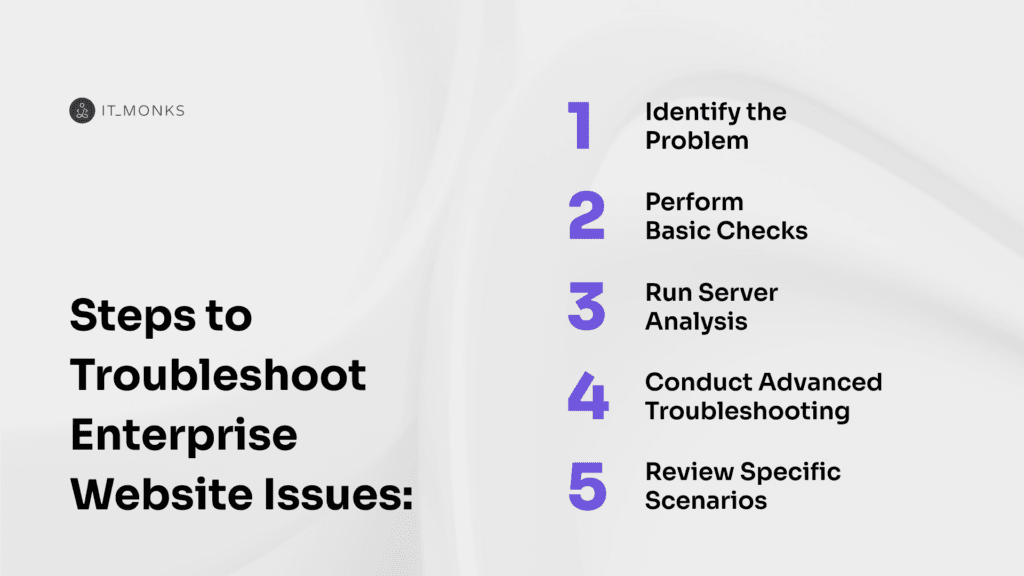
To diagnose and fix enterprise website issues, start by identifying the problem, then follow a structured approach to check key components such as network connectivity, server settings, website code, and performance.
Consider these steps for effective troubleshooting:
- Identify the problem. Gather information about the issue — whether the website is down, loading slowly, displaying errors, or if specific features aren’t working. Determine if it affects all users or just a subset.
- Do basic checks. Verify your internet connection and check if the issue persists on different devices and networks. Test the site in different browsers and clear your browser cache and cookies to resolve potential conflicts.
- Run server-side analysis. Review server logs for errors or unusual activity. Use DNS tools to ensure the DNS records are correct and resolving. Check for broken links, incorrect image paths, or invalid scripts in the website code.
- Complete advanced troubleshooting. Use browser developer tools to inspect network requests, identify loading issues, and analyze JavaScript errors. Analyze loading times, identify performance bottlenecks, and review security settings for vulnerabilities like outdated SSL certificates or weak encryption.
- Consider specific scenarios. Investigate server performance, optimize images, check caching, and analyze database queries for delays. Check user credentials, review authentication processes, and eliminate security restrictions. Review CSS conflicts, browser compatibility, and responsive design elements.
Are Hosting Issues the Most Common Reason for a Website Being Down?
Yes, hosting issues are often a leading cause of website downtime. The server where your website is hosted directly impacts its accessibility. Problems such as server outages, maintenance, hardware failures, or overloads can all lead to disruptions.
Preventing Future Enterprise Website Failures
Prevent future enterprise website failures by ensuring solid custom development, regular testing, and proactive monitoring.
Focus on these key steps to minimize the risk of your website’s malfunction:
- Address common causes early. Ensure stable server performance and avoid downtime due to server crashes or maintenance. Regularly update server settings and monitor for unusual activity.
- Test for compatibility. Conduct browser and device compatibility tests. Fix any issues related to browser incompatibility, responsive design, and performance.
- Optimize performance. Minimize slow load times by optimizing images, code, and caching. Regularly check for broken links or invalid scripts that can slow down or disrupt the website.
- Improve security. Regularly update SSL certificates, review authentication processes, and strengthen security measures to prevent unauthorized access.
- Ongoing monitoring and troubleshooting. Continuously monitor website performance. Use tools to check server settings, network connectivity, and identify any potential issues before they escalate.
Most website failures can be prevented during the initial stages of site creation. With an enterprise web development service, businesses receive a solid, tailor-made website from a professional team that ensures it meets business needs, is scalable, and performs reliably.
What are the Key Components of a Solid Enterprise Website?
The key components of a solid enterprise website include a robust infrastructure, strong security, performance optimization, redundancy systems, and proactive maintenance — elements that are easily implemented through custom web development.
With a tailored approach, businesses can better prevent downtime and address critical issues before they arise.
Custom web development allows businesses to design scalable, high-availability systems with load balancing tailored to specific needs, ensuring that service remains uninterrupted even during traffic spikes.
Security is vital for preventing critical issues. Implementing an enterprise security architecture (ESA), focusing on cybersecurity and areas like network, data, and cloud security, while following best practices, ensures system integrity and prevents website malfunctions.
Besides, performance optimization is essential to provide a smooth user experience. Fast loading speeds, content delivery networks (CDNs), and responsive design ensure that the website functions well across all devices, improving accessibility and user satisfaction.
In addition to performance, implementing automated backups and server redundancy helps an enterprise website mitigate risks like data loss or server failures.
On top of that, proactive maintenance is necessary for long-term website health. Regular monitoring, bug fixes, and adherence to accessibility standards like WCAG keep the site running smoothly.
As websites grow in complexity, the need for customized development becomes increasingly crucial. This is especially true when comparing enterprises to small business websites, where the scale of challenges and potential consequences can differ greatly.
Enterprise Websites vs. Small Business Websites
Both enterprise and small business websites may face issues related to performance and security, but the scale of consequences differs significantly.
Enterprises risk larger financial losses, severe reputation damage, and legal repercussions, whereas small businesses may face more localized impacts that can still hinder growth and customer trust.
Enterprise websites face high traffic volumes, complex infrastructures, and heightened security risks, often requiring advanced management to prevent technical failures.
Non-compliance with regulations can result in legal consequences. Downtime or performance issues can lead to significant revenue loss, reputational damage, and operational disruptions.
Small business websites face fewer technical challenges due to simpler architectures and lower traffic, but security vulnerabilities remain a concern. While the impact is smaller, downtime or performance issues can still affect revenue, reputation, and growth, especially for e-commerce businesses.
Contact

Send a Project Brief
You are currently viewing a placeholder content from Facebook. To access the actual content, click the button below. Please note that doing so will share data with third-party providers.
More InformationYou are currently viewing a placeholder content from Instagram. To access the actual content, click the button below. Please note that doing so will share data with third-party providers.
More InformationYou are currently viewing a placeholder content from X. To access the actual content, click the button below. Please note that doing so will share data with third-party providers.
More Information
